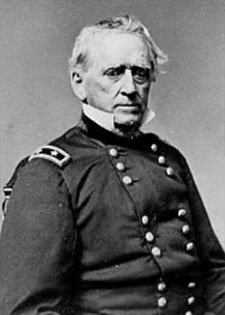John Adams Dix
Pre-Civil War

General John Adams Dix was born in Boscawen, New Hampshire in 1798. In his youth, he was educated by his father; he spent a year at Phillips Exeter Academy, and then went to the College of Montreal in 1810. His time at university was cut short by outbreak of the War of 1812. At the age of fourteen, Dix desired to join the military and fight in the War. Dix’s father, a military man in Baltimore, Maryland, helped him get a commission; John Adams Dix served for the first time at the Battle of Niagara, also known as Lundy’s Lane.[1]
At the time of his father’s death in 1813, Dix took over the role as provider for his family while advancing in the military. He served in New York City and Washington, D.C. and rose to the rank of major. While in the capital, he studied law and wrote for various newspapers, being admitted into the District of Columbia Bar in 1824.[2]
John Adams Dix married Catherine Morgan, daughter of Congressman John J. Morgan of New York State. Dix was offered the opportunity to oversee Morgan’s upstate New York land holdings in Cooperstown, and it was then that Dix resigned from the military to take this opportunity. During his time at Cooperstown, where he and his wife settled in 1828, Dix quickly became county leader of the Jackson Democrats and practiced law; by 1830, Dix had been appointed Adjutant General of New York State by Governor Throop. This appointment led to Dix becoming Secretary of State from 1833-1839, all the while pursuing interests of education, the creation of a literary and scientific magazine, and a book based on his travels to the Mediterranean and Madeira.[3]
Upon returning home from Europe, Dix was tapped to fill a term for U.S. Senator Silas Wright of New York. A Senator from 1845-1849, he showed a great interest in international affairs, Westward Expansion within the United States, and strongly opposed the expansion of slavery into new western territories. Dix was considered for both the position of Secretary of State and minister to France, but both decisions were stunted because of Southern opposition to Dix’s views on slavery.[4]
Civil War
After Fort Sumter in April of 1861, John Adams Dix was made chairman of the Union Defense Committee in New York. In this post, Dix issued a series of orders for national defense, and was advanced $2 million by President Lincoln in order to pay for military and naval necessities; this was clearly a sign of Lincoln’s trust in Dix’s abilities. Not long after this, Dix was made a major general in the military based on his distinguished military career, despite being nearly sixty-three years old at the outbreak of the Civil War.[5]
Because of his age, Dix was not seen as a candidate for field command, Dix was an important general during the Civil War because of his military authority to ensure political calm. The first posting Dix was given was to replace General Nathaniel Banks as Union Commander in Baltimore; this was largely because many politicians, Lincoln included, saw a number of the union commanders as untrustworthy. Most of the time Dix spent in Baltimore was spent in preventing leaders in Maryland from meeting and voting on whether or not to secede from the Union.[6]
After this period, Dix served as a valuable correspondent of President Lincoln, as his judgment was seen valuable because of his military experience. When commanding Fort Monroe, Dix frequently sent military reports and news from Richmond to President Lincoln. One of the most important roles that Dix played in the Civil War was in reaching an agreement with Confederate Major General D.H. Hill on the exchange of prisoners between Union and Confederate armies. This agreement, known as the Dix-Hill Cartel, was reached on July 22, 1862. Additionally, Dix was a large contributor to the suppression of the New York Draft Riots in July of 1863.[7]
Post-Civil War
After the Civil War, John Adam Dix served the government in a number of capacities. From 1866-1869, he served as minister to France a position previous denied to him for political reasons before the Civil War. He was elected Governor of New York in 1872; however, facing a great deal of corruption from the previous administration, he was unable to win his reelection in 1874. He partook in various civic causes, and spent his last days in New York City, as a vestryman at Trinity Parish Church. John Adam Dix died in New York City in 1879.
[1] “General John Adams Dix, Likenesses of New Hampshire War Heroes and Personages in the Collections,” The New Hampshire Division of Historical Resources: http://www.nh.gov/nhdhr/publications/warheroes/dixj.html.
[2] Ibid.
[3] Ibid.
[4] Ibid.
[5] “John A. Dix (1798-1879)”, Mr. Lincoln and New York: http://www.mrlincolnandnewyork.org/inside.asp?ID=74&subjectID=3.
[6] Ibid.
[7] Ibid.


